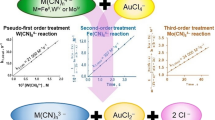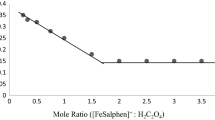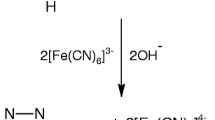Summary
Kinetic studies of the anation of the title complex by NO −2 show that it occurs in a stepwise manner leading to thecis-dinitro-complex both steps having a common rate equation:-d[complex]/dt = a[NO −2 ]/{[NO −2 ] + b}. The variation ofpseudo-first-order rate constant (kobs) with [NO −2 ] indicates that the reaction proceeds through ion-pair interchange path. Activation parameters calculated by the Eyring equation are: ΔH ≠1 = (65±7) kJ mol−1 and ΔS ≠1 = (−82±11) JK−1 mol−1 for the formation of [Co(NH3)4(NO2)(H2O)]2+, and ΔH ≠2 = (97±1) kJ mol−1 and ΔS ≠2 = (6±2) JK−1 mol−1 for the formation of [Co(NH3)4(NO2)2]+. Anation of the title complex by N −3 at pH 4.1 also occurs in a stepwise manner ultimately producing thecis-diazido species. At a fixed pH the reaction shows a first-order dependence on [N −3 ] for each step. pH-variation studies at a fixed [N −3 ] show that the hydroxoaqua-form of the complex reactsca. 16 times faster than the diaqua form. Evidence is presented for an ion-pair preequilibrium at high ionic strength (I = 2.0 mol dm−3). Activation parameters obtained from temperature variation studies are: ΔH ≠1 = (121±1) kJ mol−1 and ΔS ≠1 = (104±3) JK−1 mol−1 (for the first step anation), and ΔH ≠2 = (111±2) kJ mol−1 and ΔS ≠2 = (74±9) JK−1 mol−1 (for the second step anation). The reaction ofcis-tetraaminediaquacobalt(III) ion with salicylate (HSal−) has been studied in aqueous acidic medium in the temperature range 39.8–58.2°C. The reaction is biphasic corresponding to the anation of two salicylate ions. The kinetic results for the first phase reaction are compatible with the equation: kobs = kIPQ[HSal−]/(1 + Q[HSal−]) where Q denotes ion-pair formation constant and kIP is the first-order rate constant for the interchange reaction. The activation parameters obtained from the temperature dependence of rate are: ΔH≠ = (138±3) kJ mol−1 and ΔS≠ = (135±4) JK−1 mol−1. The reaction seems to take place by a dissociative interchange mechanism.
Similar content being viewed by others
References
F. Basolo and R. G. Pearson,Mechanisms of Inorganic Reactions, 2nd Edit., Wiley, New York, 1967, pp. 124–246.
C. H. Longford and H. B. Gray,Ligand Substitution Processes, Benjamin, New York, 1966, pp. 55–101.
R. G. Wilkins,The Study of Kinetics and Mechanisms of Reactions of Transition Metal Complexes, Allyn and Bacon, Boston, 1974, pp. 181–220.
M. B. Davies,J. Inorg. Nucl. Chem., 43, 1277 (1981).
J. Springborg and C. E. Schaffer,Inorg. Synth., 18, 83 (1978).
G. B. Kauffman, S. F. Abbott, S. E. Clark, J. M. Gibson and R. D. Meyer,Inorg. Synth., 18, 69 (1978).
M. Linhard and M. Weigel,Z. Anorg. Allgm. Chem., 267, 121 (1951).
Y. Shimura and R. Tsuchida,Bull. Chem. Soc. Jpn., 29, 311 (1956).
G. T. Morgan and J. D. M. Smith,J. Chem. Soc., 1956 (1922).
Y. Yamamoto, K. Ito, H. Yoneda and M. Mori,Bull. Chem. Soc. Jpn., 40, 2580 (1967).
J. A. Weyh and R. E. Hamm,Inorg. Chem., 8, 2298 (1969).
M.C. Ghosh and P. Banerjee,Bull. Chem. Soc. Jpn., 56, 2871 (1983).
G. Schwarzenbach, J. Boesch and H. Egli,J. Inorg. Nucl Chem., 33, 2141 (1971).
L.G. Sillen and A. E. Martell (Eds.) inStability Constants of Metal-ion Complexes, The Chemical Society, London (1964), Special Publication No. 17, pp. 55, 56.
F. Basolo, B. D. Stone, J. G. Bergmann and R. G. Pearson,J. Am. Chem. Soc., 76, 3079 (1954).
R. G. Pearson, P. M. Henry, J. G. Bergmann and F. Basolo,J. Am. Chem. Soc., 76, 5920 (1954).
D. N. Hague and J. Halpern,Inorg. Chem., 6, 2059 (1967).
S. M. Abdulnour and R. K. Murmann,J. Inorg. Nucl Chem., 32, 3617 (1970).
H. Goff, S. Kidwell, J. Lauher and R. K. Murmann,Inorg. Chem., 12, 2631 (1973).
O. Nor and A. G. Sykes,J. Chem. Soc., Dalton Trans., 1232 (1973.
C. Chatterjee and A. K. Bali,J. Coord. Chem., 11, 179 (1981).
M. L. Tobe,Inorg. Chem., 7, 1260 (1968).
Ref. 1, p. 203.
T. W. Swaddle and G. Guastalla,Inorg. Chem., 8, 1604 (1969).
J. J. Christensen, L. D. Hansen and R. M. Izatt,Hand Book of Proton Ionisation Heats and Related Thermodynamic Quantities, Wiley Interscience, New York, 1976.
A. G. Beaumont, R. D. Gillards and J. R. Lyons,J. Chem. Soc. (A), 1361 (1971).
A. C. Dash and B. Mohanty,J. Inorg. Nucl. Chem., 39, 1179 (1977).
A. C. Dash and B. Mohanty,J. Inorg. Nucl. Chem., 41, 1053 (1979).
Author information
Authors and Affiliations
Rights and permissions
About this article
Cite this article
Ghosh, M.C., Bhattacharya, P. & Banerjee, P. Kinetics and mechanism of the reactions ofcis-tetraaminediaqua-cobalt(III) with nitrite, azide and salicylate ions in aqueous acidic media. Transition Met Chem 9, 68–73 (1984). https://doi.org/10.1007/BF00619005
Received:
Revised:
Issue Date:
DOI: https://doi.org/10.1007/BF00619005




